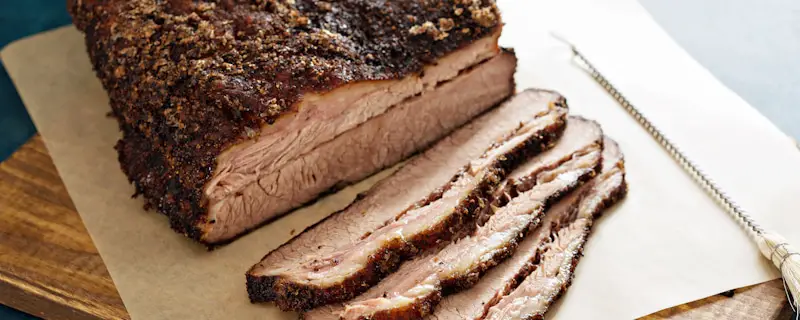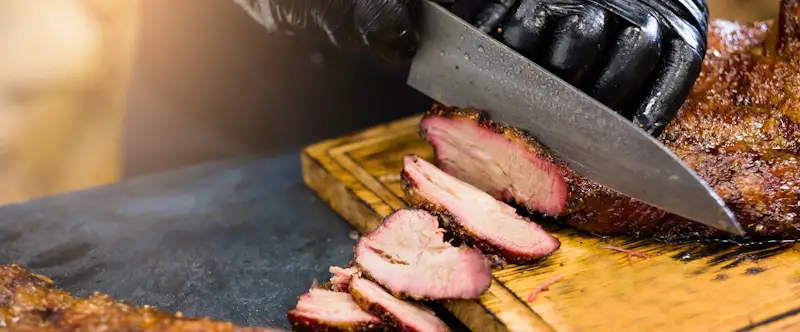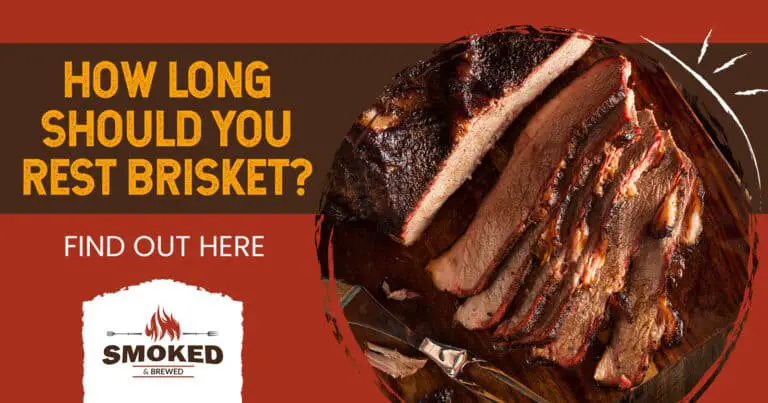Smoked briskets take a long time to cook, making it tempting to dig in immediately once they are out of the grill. However, a good pitmaster knows the importance of letting the brisket rest. But how long should you rest brisket?
The minimum duration that you can rest the brisket is a half-hour. But the ideal period is an hour as it ensures that the meat gets to absorb all the juices. If you want to go scientific about the appropriate resting period, you can use a digital meat thermometer to check the thickest part of the brisket. When the digital thermometer reads 150 degrees F, it is done resting.
Leaving your brisket to rest for more than necessary will see it get to room temperature, and that is not the best state to eat your brisket. Read on to understand why and how to rest your brisket to perfection.

Why Should You Rest Brisket
Why should you rest your brisket when you have been yearning to dig in once it is out of the smoker/grill? Well, several reasons make resting the brisket before slicing it and serving it.
First, resting plays a significant role in ensuring that the meat achieves the right taste and consistency. Although you may have done the smoking and the grilling perfectly, making a slight mistake while resting may make you get tough and dry meat.
Secondly, resting the brisket is essential as it ensures that the meat can reabsorb the juices and redistribute them evenly throughout the entire meat. Slicing immediately once your meat is out of the grill will see some of the juices pour down, which will significantly interfere with the taste of the meat.
Further, resting your brisket once you get it out of the grill/smoker allows the meat to continue cooking and achieve the desired texture and tenderness. When the brisket is resting, its internal temperature rises by about 10 degrees. Therefore, you may find it necessary to get the brisket out of the smoker when it’s 10 degrees short of the target doneness internal temperature.
How To Rest A Brisket
Even if it is your first time preparing a brisket, resting it is a straightforward process that should not give you a hard time.
The first step to resting a brisket is to pull it from the heat source. If it is covered by butcher paper or foil, remove it before transferring the meat to a cutting board, aluminum pan, dish, or any other flat surface that can hold the juices. Allow the meat to rest for thirty minutes, or preferably one hour.
While the brisket rests, its internal temperature will rise by about 10 degrees in a “carry-over cooking” condition. If you fail to factor in this condition during the smoking or grilling of your brisket, you can easily overcook it.
How Long To Let Brisket Rest
Although resting your brisket before slicing and serving is an essential step, doing it for too long or too short will not guarantee the best results. Thus, knowing how long to rest brisket is an essential skill you must master.
Before determining how long to rest brisket, one of the critical things that you need to understand is that not all briskets are the same. Brisket comes in different varieties, and you need to acknowledge this when it comes to resting the meat.
For instance, a brisket with more marbling has a lot of creamy juices that need to be reabsorbed back as opposed to leaner briskets with less juice.
The minimum time to rest the brisket is thirty minutes, with an hour being the most appropriate time to rest your brisket. While some pitmasters recommend resting the brisket for more than an hour, remember that you should not allow the internal temperature of the meat to fall below 145 degrees, as you will end up eating a cold brisket.
How Long To Let Brisket Rest In Cooler
The right duration to hold your brisket in a cooler is up to 4 hours before the temperature drops. However, a high-quality cooler may hold the brisket for an hour or two or longer, particularly when preheated with the faux cambro technique. After that, remove the brisket and let it rest at room temperature before slicing and serving.
Resting Wrapped Vs. Unwrapped
It is easy to find people wondering whether they should rest the brisket wrapped or unwrapped. Most pitmasters are yet to agree on this topic.
When you wrap your brisket before letting it rest, you make it possible for it to retain more moisture, making it more tender.
Further, wrapping helps the brisket to remain warm for an extended period.
On the flip side, wrapping the brisket tightly in a foil may soften the bark. Therefore, if you prefer your brisket crunchy, you may need to consider letting it rest without wrapping it.
However, when resting the brisket on a cooler, you have no choice other than to wrap it tightly in a foil before placing it in the faux Cambro. It will keep the brisket moist and warm for a long time.
Why Rest The Brisket In A Cooler?
Why should you rest your brisket in a cooler instead of putting it on a flat surface capable of holding the juices? Two main reasons that make the use of a cooler necessary;
Carry-Over Cooking
Once your brisket is approaching desired doneness temperature, and you need to remove it from the smoker with 5-10 minutes remaining. Putting the brisket in a cooler will allow the meat to continue cooking through carry-over cooking. In addition, it makes it easy for the juices within the meat to redistribute and therefore do the magic effectively.
Time Management
The other reason that makes it necessary to use a cooler when resting your brisket is that it is efficient in time management. You do not want to spend a lot of time cooking the brisket to eat cold and dry food. The cooler is insulated, ensuring that the meat can remain hot until you are ready to serve it.

What Factors Affect The Resting Time Of Brisket?
Resting your brisket is one of the best ways to ensure you get the most from the whole resting activity. Therefore, it is a good idea to acquaint yourself with some factors that may influence the resting time of the brisket.
Factors such as the smoking method, the type of smoker, temperatures, and the type of brisket may influence the resting time.
For instance, a brisket cooked slowly requires less time to rest because it has had enough time to go through rendering. Consequently, if you cook your brisket low and slowly, then you only need to let the brisket rest for less than 2 hours before you can slice and serve.
If you cook your medium-large-sized brisket in a small smoker, it means that the brisket cooks fast. Hence, the rendering in the smoker may not have been sufficient. To be precise, fast-cooked brisket requires more resting time to allow for rendering, which can be a minimum of four hours.
Generally, the brisket rest time will depend on the cooking temperatures, fat content, the brisket, the grade of the brisket, and weight. The table below provides an overview of the resting time to adopt for your briskets based on numerous factors.
| Select brisket | Choice brisket | Prime brisket | |
| 9lb and bellow | 30 – 90 minutes | 1 – 4 hours | 1 – 4 hours |
| 10-11 lb | 30 – 12 minutes | 2 – 6 hours | 2 – 6 hours |
| 12 – 15 lb | 45 minutes to hours | 2 – 8 hours | 2 – 8 hours |
| 16 – 20 lb | 1 hour to 4 hours | 2-10 hours | 2-10 hours |
| 21-25 lb | 1 1/2 to 6 hours | 2 – 14 hours | 3 – 14 hours |
Conclusion
The rest time for your brisket is as crucial as its smoking/grilling period. Therefore, if you are looking for a delicious meal, ensure that you rest it well. It is okay to rest low-grade brisket for 30 minutes to 6 hours, depending on its size. On the other hand, quality brisket requires a rest time of 2-14 hours, depending on various factors such as the available tools and the quality of the brisket.
Scot has loved smoking food in his free time for the last few years. Each major holiday or off-weekend, Scot spends days testing and prepping new recipes for perfection.

